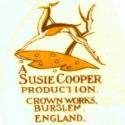Dresden Spray was first introduced in 1935 as pattern number 1001. Originally designed for Harry Wood of Wood & Sons, he decided that the pattern was too difficult to reproduce as a lithograph. Susie decided to produce the design herself and ended up with one of her best selling patterns.
Version 1017 with blue/green shaded wash border is the most commonly encountered variant. The pattern appears on most shapes produced by Susie including Kestrel dinner, tea, coffee ware and associated items, Rex shape tea and coffee ware, Doric coffee cups, lamp bases and chargers.
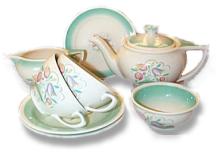
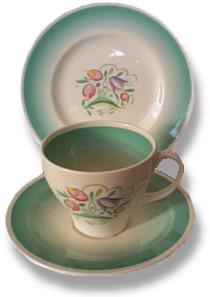
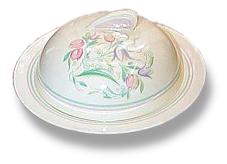
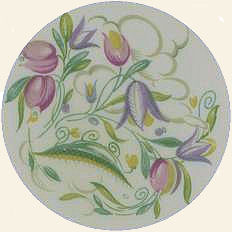
Pattern Facts
Pattern name: Dresden or Dresden Spray
Decoration technique: lithograph transfer with wash banded or lithograph transfer detailing.
First introduced: 1935 as pattern number 1001
Production period: only on earthenware and in production from 1935, production ceased somewhere around the end of the 1950s / early 1960s
 | An example factory mark often found on Dresden which includes pattern name and number. Dresden Spray was so successful that it can be found with a very wide range of various Susie Cooper Productions factory marks |
Dresden Pattern Numbers and Introduction Dates
| Pattern Number | Description | Year Introduced |
|---|---|---|
| 1001 | chestnut brown wash | 1935 |
| 1002 | gladiola green wash | 1935 |
| 1003 | Meir & swan orange wash | 1935 |
| 1004 | canton blue wash | 1935 |
| 1005 | pastel pink wash | 1935 |
| 1017 | blue/green wash | 1935 |
| 1140 | thin bands in green and pink, pink band always to outside | 1936 |
Additional Information
In the October 1939 issue of ‘Peter Jones & John Lewis Fashion and Household Gazette’ Dresden Spray in wide pale pink or green was available at the following prices:
Early morning set 9pcs. nine shillings, three & a half-pence.
Tea set 21 pcs. nineteen shillings & one halfpence.
Dinner set 26 pcs. fifty six shillings, eight & a half-pence.
100 piece set comprising Dinner, Tea and Breakfast, seven pounds, nineteen shillings and sixpence.
(Old English currency. One shilling=5p new pence, 12 old pennies=one shilling, 240 old pennies=£1.00 )
At auction in May 1996 a staggering £2070.00 was paid for a complete Rex shape tea set for six with a pink wash border. The price was fuelled by huge Japanese interest in Susie’s work at this time. Since then prices have fallen back considerably, today a tidy example of a Kestrel shape teapot can be bought for under £100.00
Sources & Credits: Graham Stewart pattern research. Susie Cooper a Collectors Guide – A.Casey. Susie Cooper an Elegant Affair – B.Youds. John Lewis Partnership Archive. All other material Mark Clemas / susiecooper.net
